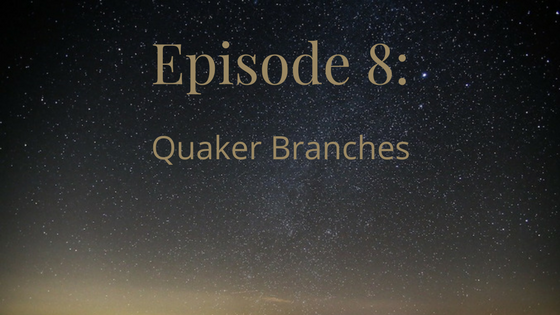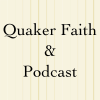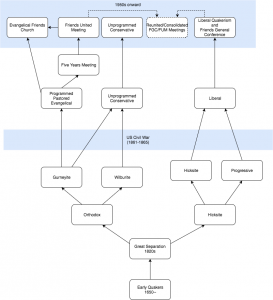Quaker Branches

This time around, we’re taking a break from the book to answer a listener request about Quaker branches. There are 4 primary Quaker branches: Evangelical, Pastoral/FUM, Conservative, and Liberal. The first two tend to have pastors and a program for their worship—a sermon, a few songs, perhaps a little bit of silent (or “open”) worship. The latter two tend to stick to unprogrammed (silent) worship. We posted a very simplified Quaker family tree on Facebook before launching this podcast, so here’s a less simplified version. For the full picture, you’re going to want to get a copy of Geoffrey Kaiser’s very large poster. There might be one on the wall of your local meetinghouse or Friends church somewhere.
We discuss this chart in the episode from the left side of the image (evangelical) the right (liberal), starting with the present day and working backward.
It’s easier to write it working from the past to the present, though, so:
History
In 1827 and 1828, tensions over Biblical authority versus the Spirit as authority came to a head (surrounded by a bunch of cultural/class stuff too), and several yearly meetings in the US split into Hicksite (Sprit as authority, concerned with staying set apart from the rest of Christianity & society to live holy lives) and Orthodox (Bible as authority, concerned with fixing social ills and less convinced that Quaker rules were necessary to live a good Christian life) versions—but not New England Yearly Meeting; they’d already kicked their liberals out.
In the 1840s, New England Yearly Meeting finally split over kind of the same argument, but with a narrower scope. John Wilbur was more moderate than Elias Hicks. Every other yearly meeting had to decide whether to side with Joseph John Gurney’s followers (Gurneyites) or John Wilbur’s (Wilburites). Some refused to take a position. Some split.
Simultaneously, the Hicksites were having disagreements over human authority (elders, overseers) and how to handle their opposition to slavery. “Is it ok to break an unjust law?” “Can we work with non-Quakers to end slavery?” And so, the Progressive Friends sprang up in Philadelphia Yearly Meeting and Genesee Yearly Meeting’s Michigan Quarter. Liberal’s aren’t immune to schism. They later got back together, with the Progressives having left some influence.
After the American Civil War (1860s), as the US expanded westward, the hiring of pastors and preaching if prepared sermons developed among Gurneyites as a practical matter to deal with spreading the faith without the proximity to Quaker hubs on the east coast. For some, this was a step too far. They joined up with the Wilburites, and now we call those folks Conservative.
The ones who decided to have pastors and prepared sermons mostly joined Five Years Meeting, which is now called Friends United Meeting. During the 20th century, some of these joined up with the Ohio group (now called Evangelical Friends Church – Eastern Region) that didn’t join Five Years Meeting and formed what’s now called Evangelical Friends Church International. Whether part of FUM or EFCI, this group of Friends is very active in mission work. Consequently, the typical Quaker worship style in Latin America and Africa is programmed with a pastor.
Today
Most of the yearly meetings that divided in 1827/28 reunited or consolidated in the 1950s and 60s. They may contain a mixture of worship styles and do contain a mixture of beliefs.
Today, the range found across Quaker branches is something the people involved in the Great Separation of 1827 could not have imagined. Evangelical Friends Churches in the US may lean toward Southern Baptists (due in part to there being one Quaker seminary in the US and scores of Baptist seminaries). Liberal Friends may be Christ-centered or be what Pink Dandelion calls “Liberal-Liberal”—influenced by secular humanism, Buddhism, or other religious traditions with no connection to Christianity. And Conservative Friends maintain a Christian identity and some degree of traditionalism (with Ohio YM being the most conservative of the three Conservative YMs), including unprogrammed worship.
Latin America and Africa are generally full of programmed Friends with pastors.
Britain and Europe are generally full of unprogrammed Liberal Friends, with Britain having a tiny minority of what they call Primitive Friends (and we call Conservative Friends) who broke away in the early 1990s.
And the US has everything we’ve talked about and a few others besides. There are parts of the US where you won’t find programmed Quaker worship at all. Maryland only has unprogrammed meetings of the consolidated variety. There are certainly parts where you won’t find any Quakers, period. North Carolina has all of the Quaker branches. Some areas, like southeastern Virginia, are full of Evangelical Friends with only a few Quakers from other branches.
What was the biggest surprise for you about the variety of Friends?
References
- Primitive Friends in Britain
- An Introduction to Quakerism by Pink Dandelion
- Top 10 Mennonite Schisms
Podcast: Play in new window | Download
Subscribe: Apple Podcasts | Email | RSS

